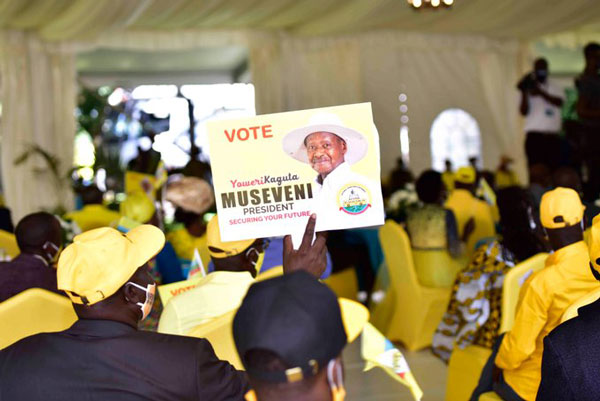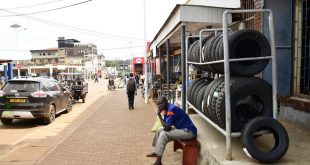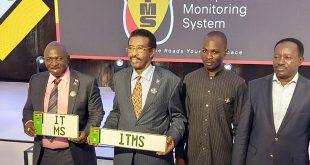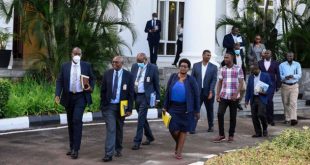
To go back to the questions. In 1900, the economy and society of Uganda were pre-capitalist, of course, pre-industrial, mainly non-money (the limited use of ensiimbi – cowrie shells – notwithstanding), a barter trade economy, servicing a three class society of feudalists, Agriculturalists (cattle keepers and other livestock keepers, crops growers and fishermen) and artisans (abaheesi, ababaizi, abanogoozi, abakomagyi, abahazi, abaremi, etc., – blacksmiths, carpenters, pottery makers, bark-cloth makers, leather processors, shoe-makers, respectively). Quite quickly, colonialism suppressed the two classes – the feudalists and the artisans. The feudalists were suppressed because they were competing for power with the colonialists. The Artisans were suppressed because they were making products that colonialism was importing – plates, clothes, shoes, medicines, hoes, pangas, etc. This, therefore, left only one major social class – the peasants engaged in crops growing, livestock rearing and fishing. Slowly, this group came to be divided in two groups: a minority that was co-opted into producing cash crops for the colonial economy and the big majority that continued to only engage in subsistence farming (okukolera ekida kyoonka, tic me ic keken). That is how, by 1962, the economy of Uganda was characterized by the colonialists as an economy of the 3Cs and 3Ts, being Coffee, Cotton and Copper for the 3Cs and Tobacco, Tourism and Tea for the 3Ts. As you can see, the non-agricultural activities here, were only copper and tourism. The other four were agricultural: cotton, coffee, tea and tobacco. In the brief period after Independence of 1962-1970, this enclave economy, meaning an island of modernity in a sea of backwardness and moneylessness, grew quite abit. By 1970, coffee production was 3.4 million bags, tea was 18million kgs, cotton had reached 480,000 bales, tobacco was 3,414 tonnes and copper was 16,958 metric tonnes per annum. Out of a total of 2,012,000 homesteads according to the 1969 Census, 1,922,000 were involved with subsistence farming (okukolera ekida kyoonka), approximately 96% of the total homesteads. The workers in the mining and quarrying sector were 7,660 and those in the manufacture of food products were 12,696 and miscellaneous manufacturing Industries were 26,759. That meant that, by 1970, you had 1,922,000 homesteads in subsistence farming (okukolera ekida kyoonka, tic me ic keken), i.e. 96% of all the homesteads were in moneylessness.
With the coming in of Idi Amin, but also with the Nakivubo Announcements of 1970, actions that either uprooted the entrepreneurial class of the Asians and other foreigners or interfered with their ownership and also political instability and insecurity that ensued for 16 years up to 1986, the small enclave of a modern economy that had emerged between 1900 and 1970, almost entirely disappeared. Out of the 23 million kgs of tea of 1970, only 3 million kgs were being exported by 1986; out of the 480,000 bales of cotton, only 49,000 bales were being exported by 1986; copper was zero; tobacco had declined from 3,523 tonnes to 3,400 tonnes; sugar was zero; fertilizers – zero; coffee had fought on and 2,700 tonnes 60kg-bags were still being exported; etc.
It is against that background, that you should understand this voluminous Manifesto of 374 pages. The Manifesto, first of all, restates our ideological principles of Patriotism, Pan-Africanism, Social-economic transformation and democracy. These are principles designed to deal with the following strategic (long-term) questions:
- How shall we ensure the prosperity of Ugandans by removing all the barriers – conceptual and physical – to the rapid and free flow of goods and services within Uganda as one market? To make it clear to all and sundry that Uganda is more useful to the Ugandan producers of goods and services than the individual tribal areas – Ankole, Buganda, Acholi etc. To ensure that it is clear to all that mwoyo gwa Uganda will ensure our prosperity better than the mwoyo gwa gwanga of the tribes. It is the Baganda cattle traders – Walusimbi Mpanga and Bukyenya (Bukenya) of Mbarara and a Whiteman, Shear of Ishaka, that was buying slaughter cattle for Kilembe Mines, that supported my education, my eventual prosperity, by buying our cattle so that Mzee Kaguta could pay my school fees. Yes, the Banyankore of Ntungamo and Kashaari contributed to my education by also rearing cattle, like our family, so that there were enough cattle to attract the said cattle traders every month to come and buy our cattle. If it had been only our family rearing cattle and taking one cow or bull, once in a while, to the monthly kikomera (cattle Auction Market), the traders would not have come. Marketing for our lonely cow or bull once in a while, may be every school term, would have been impossible. Therefore, the Banyakole engaging in the uniform activity of cattle-rearing, also contributed to my education. However, the non-Banyankore, the Baganda traders and a White man buying cattle for Kilembe Mines workers and for Kampala, were our real saviours from moneylessness.
- The second question is: “Is the Uganda Market enough to guarantee our prosperity once all the Ugandans wake up from kulambaala (sleeping) and from okukolera ekida kyoonka and produce big volumes of maize, milk, beef, bananas, cassava, sugar, industrial products etc.?” The answer is: “No, the Ugandan market is not enough; we also need the East African market; the African market and the World market”. We shall get access to the East African and African markets through the economic integration of those areas as we have done under EAC and CFTA. We shall more easily access the global markets if we negotiate as East Africa or as Africa. Uganda alone, does not have the clout to negotiate credibly with the big markets of the USA, China, India, Russia, EU.
- Question No. 3 is: “How can we guarantee the strategic security, the long-term security, the eternal security, of the Ugandan people and the other African peoples against all possible threats of whatever capacity?” “Can economic development alone, through economic integration, guarantee this strategic security?” The answer is: “No.” During the Second World War, the first victims of the Fascist aggression of Germany, were the small but advanced countries of Belgium, Denmark and even France, not to talk of Chechslovakia, Poland, Norway, Yugoslavia, Greece, etc. Since 1963, we have been supporting the idea of the political re-organization in order to crystallize political units that have capacity to defend us against all possible threats. Certainly, Uganda cannot easily defend itself in a conventional attack by some of the super-powers. We would have to use the very expensive Afghanistan-style approach, of a protracted guerilla war. All the greedy actors, however, would be put out of temptation if Africa re-organized itself, as long advocated by some of our independence leaders such as Kwame Nkrumah, Julius Nyerere, Modibo Keita, Muamar Gaddafi, Gamal Abdul Nasser, Sekou Toure and Abeid Karume. Some of these leaders advocated for the continental political Union – an All-Africa Continental Government. Others, however, supported regional Federations such as the East African Federation. I have always supported the latter, mainly, because of the factors of similarity in cultures and languages or, at least, linkages in culture and language. These similarities assist cohesion among these political units.
In the case of East Africa, we have, mainly, the Bantu speaking peoples, some Cushitics (Somalis), the Nilotics, the Nilo-hamitic and the Sudanic (Lugbara – Madi). The languages of all these groups, are either similar or linked. I always highlight for Ugandans, not just similarities among the Bantu dialects of Uganda and East Africa and Central Africa, but also their linkages with the Nilotic dialects and even the Cushitic languages like Somali. To take one example, the Somali word for cow is Saa. Many of the Bantu dialect speakers in Uganda, Tanzania, Rwanda and, maybe even Burundi, I am sure, see the linkage of this word to our languages. Saa (busa, amasha etc.), in those Bantu dialects, the speakers of those dialects know that this is the word specifically for certain herbivore’s dung. It is only used for the dung of cattle, buffaloes and elephants. It is not used for the dung of goats, pigs, sheep, etc. It is these similarities and linkages that the African revolutionaries should use to crystalize powerful Federations that can ensure the future of Africa. You find those similarities and linkages, in Southern Africa, West Africa, the Horn of Africa, North Africa, the Mahgreb etc. In the case of East Africa, we have the additional advantage of Swahili, which is a neutral dialect that belongs to no tribe. A very powerful African State can be built around these similarities, involving the whole of East Africa, Congo and may be Zambia and Malawi. This would be a very powerful and cohesive State of 2.2 sq. miles, exceeding the geographical size of the United States, with, a potentially, huge population and alot of natural resources – rivers, Lakes, Oceans, forests, minerals, agriculture, energy etc. I am glad, the members of East African Co-operation (Kenya, Tanzania, Rwanda, South Sudan, Burundi and Uganda), both by Treaty and by subsequent decisions, have agreed on the strategy of starting with the Confederation as a first step to the ultimate goal of the political Federation.
It is now 63 years since Ghana’s Independence in 1957. The Post-Independence African leaders, except for Mwalimu Nyerere and Mzee Karume, have succeeded in building a Latin America in Africa instead of building a United States of Africa in Africa as the wishes of the Wazee – Nkrumah, Nyerere, Modibo Keita, Sekou Toure, Nasser and Gadaffi – were. We have failed to build a centre of gravity, a guaranteeing force for the African Race, to guarantee a secure and prosperous future for that much traumatized race. The NRM has invested alot in that struggle in the last 57 years, eversince the Declaration of our leaders in Nairobi on the 6th of June, 1963. That is when Mzee Kenyatta, Nyerere and Obote, with delegations from Somalia, declared that the Federation would be launched before the end of 1963. We are glad, working with our brothers and sisters from the other East African States, we restored the EAC which had collapsed in 1977. We are also glad, as already said above, that the East African States have agreed to the creating of a Confederation as a first step to the, eventual, political Federation of East Africa, may be, eventually attracting other countries such as Congo, Malawi and Zambia because our languages and cultures are close. In this kisanja, therefore, we should vigorously continue pursuing this goal to ensure its realization. In case some of the sister countries have any hesitation vis a vis moving forward, we shall propose to the brothers and sisters, the concept of variable geometry. By this method, those States that are ready, should go ahead and the others can come later, just like Tanganyika and Zanzibar did while forming the United Republic of Tanzania – Serikari ya mungano wa Tanzania. It is amazing, that many political actors in Africa never talk about this, yet it is the only insurance for the future of the Africans. Why did we oppose Amin from the word go? We did not know that he had started killing people at that time. It was because we saw that he was incapable of understanding our principles of patriotism and Pan-Africanism, especially. We cannot be part of any effort that does not include patriotism and Pan-Africanism. It is on account of this long journey, that we, sometimes, get into collision with the arrivists, who think that by taking control of Uganda or any of the former colonies, we have arrived.
 The Independent Uganda: You get the Truth we Pay the Price
The Independent Uganda: You get the Truth we Pay the Price


